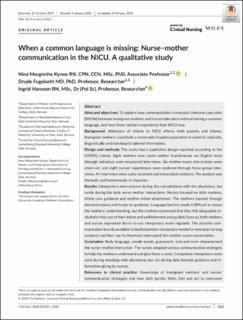| dc.contributor.author | Kynø, Nina Margrethe | |
| dc.contributor.author | Fugelseth, Drude Merete | |
| dc.contributor.author | Hanssen, Ingrid | |
| dc.date.accessioned | 2021-01-27T09:02:23Z | |
| dc.date.available | 2021-01-27T09:02:23Z | |
| dc.date.created | 2020-07-17T10:07:49Z | |
| dc.date.issued | 2020 | |
| dc.identifier.citation | Journal of Clinical Nursing (JCN). 2020, 29 (13-14), 2221-2230. | en_US |
| dc.identifier.issn | 0962-1067 | |
| dc.identifier.uri | https://hdl.handle.net/11250/2724917 | |
| dc.description.abstract | Abstract
Aims and objectives:
To explore how communication in neonatal intensive care units (NICUs) between immigrant mothers and nurses take place without having a common language, and how these mothers experience their NICU stay.
Background:
Admission of infants to NICU affects both parents and infants. Immigrant mothers constitute a vulnerable hospital population in need of culturally, linguistically and individually tailored information.
Design and methods:
The study had a qualitative design reported according to the COREQ criteria. Eight mothers who spoke neither Scandinavian nor English went through individual semi-structured interviews. Six mother–nurse interactions were observed, and eight nurses' experiences were explored through focus-group inter- views. All interviews were audio recorded and transcribed verbatim. The analysis was thematic and hermeneutic in character.
Results:
Interpreters were present during the consultations with the physicians, but rarely during the daily nurse-mother interactions. Nurses focused on daily routines, infant care guidance and mother–infant attachment. The mothers learned through demonstrations and hands-on guidance. Language barriers made it difficult to assess the mothers' understanding, but the mothers expressed that they felt adequately in- cluded in the care of their infant and well informed and guided. Even so, both mothers and nurses expressed desire to use interpreters more regularly. The pictorial com- munication boards available lacked important vocabulary needed in neonatal nursing contexts and their use furthermore interrupted the mother–nurse conversation. Conclusion: Body language, simple words, guesswork, trial and error characterised the nurse–mother interaction. The nurses adopted various communication strategies to help the mothers understand and give them a voice. Competent interpreters were used during meetings with physicians, but not during daily bedside guidance and in- formation giving by nurses.
Relevance to clinical practice:
Knowledge of immigrant mothers' and nurses' communication strategies and how both parties think, feel and act to overcome communication problem is necessary to improve clinical practice and reduce com- munication barriers. | en_US |
| dc.language.iso | eng | en_US |
| dc.rights | Navngivelse 4.0 Internasjonal | |
| dc.rights.uri | http://creativecommons.org/licenses/by/4.0/deed.no | |
| dc.subject | Nyfødtsykepleie | en_US |
| dc.subject | Kvalitativ forskning | en_US |
| dc.subject | Kommunikasjon | en_US |
| dc.title | When a common language is missing: Nurse–mother communication in the NICU. A qualitative study | en_US |
| dc.type | Peer reviewed | en_US |
| dc.type | Journal article | en_US |
| dc.description.version | publishedVersion | en_US |
| dc.source.pagenumber | 2221-2230 | en_US |
| dc.source.volume | 29 | en_US |
| dc.source.journal | Journal of Clinical Nursing (JCN) | en_US |
| dc.source.issue | 13-14 | en_US |
| dc.identifier.doi | 10.1111/jocn.15212 | |
| dc.identifier.cristin | 1819673 | |
| cristin.ispublished | true | |
| cristin.fulltext | original | |
| cristin.qualitycode | 2 | |

